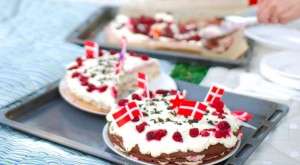Birthdays in Denmark Posted by Bjørn A. Bojesen on Jul 31, 2014 in Traditions

Thomas Angermann at Flickr. (Modified according to the Creative Commons License.)
Tillykke med fødselsdagen! (Happy birthday!) Since July is crowded with birthdays in my family, I thought it would be nice ending the month with some facts about fødselsdagsfejring (birthday celebration) in Denmark.
Danes are the most birthday-obsessed people I’ve come across yet. For many børn (children) their fødselsdag is just as important as jul (Christmas), if not more so. In Christmas, after all, you have to share the pool of gifts with your søskende (siblings) and forældre (parents). A fødselsdagsbarn (”birthday child”), on the other hand, gets all the gaver (gifts) for himself.
Being a ”birthday child” isn’t just for children, though. Far og mor (mum and dad) have to get gifts on their birthdays too, and so it goes on the entire life – even though some have invented the word fødselar [foselARE] for the more mature celebrants. Especially important are the runde fødselsdage (”round birthdays”): 25, 30, 40, 50, 75 etc.
Even shops and institutions celebrate their birthdays in Denmark; it isn’t uncommon to come across a supermarket that’s full of red and white Dannebrog (the Danish flag) because de fejrer (they’re celebrating) their 25 år, for example.
Besides gaver, flag and gæster (guests), another important ingredient in a fødselsdagsfest (birthday party) is kager (cakes). Some parents bager (bake) a kagemand (”cake man”) to their little child. As the name says, it’s a cake shaped like a mand (man) – or a kvinde (woman). Kagemanden is decorated with glasur (icing), slik (candy, sweets) like chokoladeknapper (”chocolate buttons” like m’n’ms), and tiny lys (candles).
For older kids and adults, all kinds of cakes or boller (buns) can be used as fødselsdagskage (birthday cake). The most common one, however, is the classical Danish lagkage [LAOWkay] (layer cake) with flødeskum (whipped cream). Lagkagen is also lit with tiny lagkagelys (”layer cake candles”). There’s usually one candle for hvert år (each year [in the life of the celebrant]). The fødselsdagsbarn/fødselar is now expected to blæse alle lysene ud på én gang (blow out all the candles at once). If there are any candles still aflame afterwards, they’re often said to represent something, like for instance how many kærester (girlfriends/boyfriends) the child is going to have.
An indispensable part of a proper Danish fødselsdag is singing fødselsdagssangen (the birthday song). There are a couple of different songs to choose from; the one that’s most widely sung starts like this:
I dag er det Oles fødselsdag,
hurra hurra hurra
Han sikkert sig en gave får,
som han har ønsket sig i år
og dejlig chokolade med kager til.
Today it’s Ole’s birthday
hooray hooray hooray
He’ll surely get (himself) a gift
that he’s been wishing this year,
and delicious hot chocolate with cakes.

Build vocabulary, practice pronunciation, and more with Transparent Language Online. Available anytime, anywhere, on any device.
About the Author: Bjørn A. Bojesen
I was born in Denmark, but spent large parts of my childhood and study years in Norway. I later returned to Denmark, where I finished my MA in Scandinavian Studies. Having relatives in Sweden as well, I feel very Scandinavian! I enjoy reading and travelling, and sharing stories with you! You’re always welcome to share your thoughts with me and the other readers.




Comments:
demo:
nice article.
Mary ruterbories:
. My family ruter Bor IES we’re from Sweden I have tried two Trace them back to Sweden and have had a problem with that I’ve always wanted to know about the Swedish culture my my dad’s family was from Denmark and they went to Germany the 1800’s they always said they were German but they never acted that way thank you
Bjørn A. Bojesen:
@Mary ruterbories Hej Mary! Thank you for your comment. I hope you’ll discover more about your Danish pre-history! 🙂 Learning about one’s roots is fascinating, isn’t it?